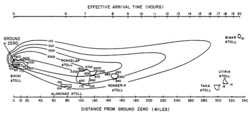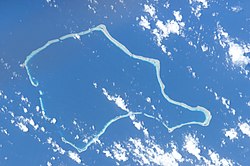Rongelap Atoll
 | |
 | |
| Geography | |
|---|---|
| Location | North Pacific |
| Coordinates | 11°19′N166°47′E/ 11.317°N 166.783°E |
| Archipelago | Ralik |
| Total islands | 61 |
| Area | 21 km2(8.1 sq mi) |
| Highest elevation | 3 m (10 ft) |
| Administration | |
| Demographics | |
| Population | 0[1](2021) |
| Ethnic groups | Marshallese |


Rongelap Atoll/ˈrɒŋɡəlæp/RONG-gə-lap(Marshallese:Ron̄ļap,[rʷɔŋʷ(ɔ)lˠɑpʲ][3]) is an uninhabitedcoral atollof 61 islands (ormotus) in thePacific Ocean,and forms alegislative districtof theRalik Chainof theMarshall Islands.Its total land area is 8 square miles (21 km2). It encloses alagoonwith an area of 1,000 square miles (2,600 km2). It is historically notable for its close proximity toUShydrogen bombtests in 1954, and was particularly devastated byfalloutfrom theCastle Bravotest. The population asked the US to move them (several times) from Rongelap following the test due to high radiation levels with no success so they asked global environmental groupGreenpeaceto help. TheRainbow Warriormade four trips moving the islanders, their possessions and their homes to the island ofMejatoin theKwajalein Atoll,180 kilometers away.
History
[edit]The Marshall Islands, of which Rongelap Atoll is a part, were first settled byMicronesians.
The first sighting recorded byEuropeanswas bySpanishnavigatorÁlvaro de Saavedraon 1 January 1528.[4]Together withUtirik,AilinginaeandTokeatolls, they were charted asIslas de los Reyes(Islands of the Three Wise Kings inSpanish) due to the proximity ofEpiphany.Fourteen years later it was visited by the Spanish expedition ofRuy López de Villalobos.[5]
Rongelap Atoll was claimed by theGerman Empirealong with the rest of the Marshall Islands in 1885.[6]After World War I, the island came under theSouth Seas Mandateof theEmpire of Japan.The base became part of the vast USNaval Base Marshall Islands.Following the end of World War II, Rongelap came under the control of the United States as part of theTrust Territory of the Pacific Islands.
Nuclear testing impact
[edit]Time line
[edit]1946:United StatesNavy evacuatesBikini AtollIslanders prior tonuclear weapons tests.
March 1, 1954:United Statesdetonates 15-megatonhydrogen bomb(Castle Bravo test) allegedly unaware thatfalloutwill reach Rongelap.[7]
March 3, 1954: US evacuates Rongelap inhabitants toKwajaleinAtoll. Islanders have vomiting, diarrhea, skin burns, and some later experience hair loss. They were suffering fromacute radiation syndrome.
1955-1957: Internally displaced Rongelapese inhabitants repeatedly request permission from theUS Governmentto return to their atoll.
1957:Atomic Energy Commissiondeclares Rongelap safe for re-habitation. US scientists note: "The habitation of these people on the island will afford most valuable ecological radiation data on human beings."[8]
1958: Rates of Rongelap miscarriages and stillbirths twice the rate of unexposed women.[9]
1963: Firstthyroid tumorsbegin to appear.
1971: Independent Japanese medical team invited by Rongelap magistrate denied permission[who?]to visit by US citing "visa problems."
1976: Report finds 69% of Rongelap children who were under 10 in 1954 have developed thyroid tumors.[citation needed]
1984:Marshall IslandssenatorJeton Anjainrequests evacuation assistance fromGreenpeacebecause the US denies the senator's requests for evacuation.
1985:Rainbow Warriormakes three trips to evacuate the Rongelap community toMejatoandEbeyeislands inKwajaleinAtoll.
1986: Nuclear test compensation approved,[who?]setting aside a $US150 million trust fund.
1989:United States Department of Energydetermines Rongelap safe for habitation.
1994: Independent scientific study[who?]finds that depending on dietary restrictions, 25 to 75% of Rongelap population would exceed the 100 mrem maximum annual exposure limit set.
2000:Marshall Islandsgovernment submits Change of Circumstances petition asking for significantly more compensation than the $US150m.
2005:Bush Administrationdetermines it has no legal responsibility to provide additional nuclear test compensation.
2007: TheNuclear Claims Tribunalawards Rongelap more than $1 billion as fair damages for its land damage claim, however, since the $US150m trust fund is almost completely depleted this compensation can never be paid.[clarification needed]
2012:United States government(Barack Obama administration) reasserts its position that it has satisfactorily compensated Rongelap victims.[10]
The tests
[edit]From 1946 through 1958 theUnited Statesmilitary conducted numerousatmosphericnuclear weapons tests,includinghydrogen bombtests, primarily atBikini Atoll,about 120 kilometers (75 mi) from Rongelap Atoll. On March 1, 1954, the testing of theCastle Bravohydrogen device produced an explosion that was 2½ times more powerful than predicted, and produced unexpected amounts of fallout[11]that resulted in widespreadradioactive contamination.[12][13][14]Themushroom cloudcontaminated more than 7,000 square miles (18,000 km2) of the surroundingPacific Oceanincluding some of the then inhabited surrounding islands includingRongerik Atoll,Rongelap Atoll (120 kilometers (75 mi) away) andUtirik Atoll.[15]
Irradiateddebris fell up to 2 centimeters (0.79 in) deep over the island. A United States military medical team visited the island withgeiger countersthe day after the fallout, but left without telling the islanders of the danger they had been exposed to.[16]Virtually all the inhabitants experienced severeradiation sickness,including itchiness, sore skin, vomiting, diarrhea, and fatigue. Theirsymptomsalso included burning eyes and swelling of the neck, arms, and legs.[17]The inhabitants were forced to abandon the islands, leaving all their belongings, three days after the test. They were relocated toKwajaleinfor medical treatment.[17][18]Six days after the Castle Bravo test, the U.S government set up a secretprojectto study the medical effects of the weapon on the residents of theMarshall Islands.[19]
TheUnited Stateswas subsequently accused of having used the inhabitants in medical research (without receiving consent) to study the effects of nuclear exposure.[16]Until that time, the United StatesAtomic Energy Commissionhad given little thought to the potential impact of widespread fallout contamination and health and ecological impacts beyond the formally designated boundary of the test site.
Failed return to the atoll
[edit]In 1957, three years later, the United States government declared the area 'clean and safe' and allowed the islanders to return,[20]though they were told to stick to canned foods and avoid the northern islets of the atoll.[16]Evidence of continued contamination mounted, however, as many residents developed thyroid-tumors,[16][17]and many children died ofleukemia.[17]The magistrate of Rongelap,John Anjain,whose own son died of leukemia, appealed for international help, without significant response.
Relocated by Greenpeace
[edit]In 1984,Marshall Islandssenator,Jeton Anjainapproached the environmental groupGreenpeaceto seek their help in relocating the people of Rongelap and in 1985, 'Operation Exodus' took place. In three trips, theRainbow Warriormoved approximately 350 people and 100 metric tons (98 long tons; 110 short tons) of building material.[16]to the islets ofMejatoandEbeyeonKwajaleinatoll, approximately 180 kilometers (110 mi) away. The operation took 11 days, moving everyone from 80-year-olds to newborns, as well as their homes and belongings.Ebeyeis significantly smaller than the islands of Rongelap, and joblessness, suicide, and overcrowding have proven to be problems following the resettlement.[citation needed]
Compensation awarded
[edit]In September 1996, theUnited States Department of the Interiorsigned a $45 million resettlement agreement with the islanders, stipulating that the islanders themselves will scrape off a few inches of Rongelap's still contaminated surface. However, this is an operation deemed impossible by some critics.[according to whom?]In recent years,James Matayoshi,the mayor of Rongelap, claimed that the cleanup was successful and envisioned a new promising future for the inhabitants and for tourists.[21]Scientific measurements made in August 2014 verified a safe level of radiation on Rongelap.[22]
Aftermath
[edit]In 1991, the People of Rongelap andJeton Anjainreceived theRight Livelihood Award"for their steadfast struggle against United States nuclear policy in support of their right to live on an unpolluted Rongelap island."
In 2019 Chinese investor Cary Lan leased a large part of the atoll for a proposed special economic zone, in what was seen as part of ongoing efforts by China to expand its reach into the Pacific and conductchequebook diplomacyagainstTaiwan.[23]
After his arrest in Thailand in 2020, the project was abandoned. He was deported to the United States in 2022 for allegedly bribing elected officials in this case.[24]
Education
[edit]Marshall Islands Public School Systemoperates Mejatto Elementary School, which serves descendants of the community in Mejatto that resided in Rongelap Atoll.[25]
References
[edit]- ^"Republic of the Marshall Islands 2021 Census Report, Volume 1: Basic Tables and Administrative Report"(PDF).Pacific Community (SPC): Statistics for Development Division.Pacific Community.May 30, 2023.RetrievedSeptember 27,2023.
- ^Glasstone, Samuel; Dolan, Philip J. (1977).The Effects of Nuclear Weapons (3rd ed.).U.S. Department of Defense, U.S. Atomic Energy Commission. pp. 436–437.
(page 436.) 9.107 A radiation dose of 700 rads over a period of 96 hours would probably prove fatal in the great majority of cases.
- ^"Marshallese-English Dictionary - Place Name Index".trussel2.
- ^Brand, Donald D.The Pacific Basin: A History of its Geographical Explorations.The American Geographical Society, New York, 1967, p.121.
- ^Sharp, Andrew.The discovery of the Pacific Islands.Oxford, 1960, p. 23.
- ^Churchill, William(1920). "Germany's Lost Pacific Empire".Geographical Review.10(2): 84.JSTOR207706.
- ^United States National Research Council Committee on Radiological Safety in the Marshall Islands (1994).Radiological Assessments for Resettlement of Rongelap in the Republic of the Marshall Islands.National Academies Press. pp. Introduction.
- ^Johnson, Giff (February 1979). "Micronesia: America's 'strategic' trust".The Bulletin of the Atomic Scientists.35(2): 15.Bibcode:1979BuAtS..35b..10J.doi:10.1080/00963402.1979.11458582.
- ^De Ishtar, Zohl(May 2003)."Poisoned Lives, Contaminated Lands: Marshall Islanders Are Paying a High Price for the United States Nuclear Arsenal".Seattle Journal for Social Justice.2(1): 291.
- ^"U.S. Statement on the Report of the Special Rapporteur".geneva.usmission.gov.18 September 2012.
- ^"The Bikini Atoll Survey" Operation Crossroads, "1946-47".Smithsonian Institution. Archived fromthe originalon 2 May 2013.Retrieved8 August2013.
- ^Kaleem, Muhammad (2000)."Energy of a Nuclear Explosion".The Physics Factbook.Archivedfrom the original on 10 August 2007.Retrieved2007-07-22.
- ^Lorna Arnold and Mark Smith. (2006).Britain, Australia and the Bomb,Palgrave Press, p. 77.
- ^John Bellamy Foster (2009).The Ecological Revolution: Making Peace with the Planet,Monthly Review Press, New York, p. 73.
- ^Titus, A. Costandina (2001).Bombs in the Backyard Atomic Testing and American Politics.Reno: University of Nevada.ISBN9780874173703.[permanent dead link]
- ^abcde"The evacuation of Rongelap".Retrieved2012-09-21.
- ^abcdIsobelle Gidley and Richard Shears (1986).The Rainbow Warrior Affair,Unwin, p. 155.
- ^Gerald H. Clarfield and William M. Wiecek (1984).Nuclear America: Military and Civilian Nuclear Power in the United States 1940-1980,Harper & Row, New York, p. 207.
- ^"Establishment of Program 4 and Project 4.1 in Castle"(PDF).James Reeves to Frank D. Peel.11 March 1954. Archived fromthe original(PDF)on 27 September 2006.Retrieved16 June2020.
- ^McCool, Woodford C. (1957-02-06),Return of Rongelapese to their Home Island - Note by the Secretary(PDF),United States Atomic Energy Commission, archived fromthe original(PDF)on September 25, 2007,retrieved2007-11-07
- ^"Rongelap Atoll Local Government - Marshall Islands".
- ^Lestch, Corinne."Discovering Nuclear Studies Through the Marshall Islands".Columbia College.Columbia University.Retrieved18 November2017.
- ^"Pacific islands: a new arena of rivalry between China and the US".The Financial Times.9 April 2019.
- ^"Marshall Islands: Chinese pair plotted 'mini-state' in Pacific nation".BBC News.8 September 2022.
- ^"Public SchoolsArchived2018-02-21 at theWayback Machine."Marshall Islands Public School System. Retrieved on February 21, 2018.
External links
[edit]- Marshall Islands site
- Entry at Oceandotsat theWayback Machine(archived December 23, 2010)
- Rongelap Atoll official site
- Bikini - mon amour:the film byOliver Herbrichshows the Greenpeace evacuation and the resettlement on Mejato island 1987.
- Radio Bikini:Oscar-nominated 1987 documentary on the 1946 atomic bomb tests on Bikini Atoll and the effects on the Bikinians as well as the US sailors who witnessed the tests.
- Het Einde van de WereldThe End of the World (1995/VPRO-TV/Theo Uittenbogaard) aDutchdocumentary on the history of the people of the island Rongelap, who were evacuated due to fallout from the Bikini nuclear tests and their (inc. John Anjain) hearing by a Senate Committee in Washington DC
Further reading
[edit]- "Biological and environmental effects of nuclear war. Hearings before the Special Subcomm. on Radiation, Joint Comm".Congress, U. S. At. Energy, 86th Congress, 1st session, Washington, US GPO, 1959.
{{cite journal}}:Cite journal requires|journal=(help)

